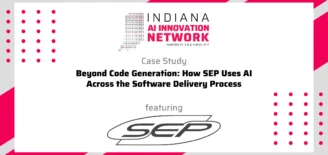Vennli software helps companies develop and execute growth strategies
Companies of all sizes from all industries strive to uncover the growth strategy that will take them to the next level. What many companies learn, disturbingly slowly, is that not all strategic growth processes are the same.
Vennli, a cloud-based software-as-a-service startup coming out of Innovation Park at Notre Dame is helping companies develop and execute growth strategies based on a key component missing from a lot of other methodologies.
We’ve all been there — the weekend corporate retreats where strategy sessions are going to transform the business, but mostly consist of uncomfortable conversations and even more uncomfortable beds. SWOT analysis is always popular, but probably more for its onomatopoetic nature than for its strategic usefulness. (You have to actually do something with those yellow legal pads of SWOTs to get the benefits.) And at the opposite end of the spectrum are the expensive, time-consuming strategy processes that not only decrease productivity throughout discovery, but deliver surprisingly few actionable results.
The missing component that becomes obvious to those of us who have endured fruitless strategic endeavors in the past is this: no matter what process you use, if the customer isn’t at the center of it-it isn’t going to provide you what you need to create a growth strategy that works.
Enter Vennli. Based on teachings in his book, Grow by Focusing on What Matters: Competitive Strategy in 3-circles (Strategic Management Collection), Joe Urbany, professor of marketing in the Mendoza College of Business at Notre Dame, and co-founder Gary Gigot launched the software company 18 months ago. The goal was clear: make Vennli the single standard for business growth strategy in the way that Visio is the single standard for business drawing creation. Gary knows a thing or two about how to achieve that goal. He was the chief marketing officer at Visio who made it happen.
Gary and Customer Success Manager Dan Farrell presented Vennli at TechPoint’s Tech Thursday sponsored by WGU Indiana and hosted by Faegre Baker Daniels.
“We found very consistent pain points across businesses that we talked to and it goes like this — people do all of this paper-based SWOT and other things and it usually doesn’t lead to much afterwards,” Gary said. “What we’ve done is provide a software product that puts customers at the center of the process as you’re trying to arrive at specific choices for growth campaigns. We did a lot of research on how people actually drive growth and created what we call the growth vLens™.”
Powered by a patent-pending algorithm, Vennli’s vLens is a super-charged, three-circle Venn diagram that dynamically maps customer choice factors — the attributes customers weigh when deciding what to purchase. It’s not serendipity that everything from the intellectual property to the software user interface and even the company logo is made up of the same blue, red and yellow circles.
Here is the very stripped down summary of how it works. If a choice factor falls within the blue circle, it’s something the customer thinks you do better than the other guy. If it falls in the red circle that is something the customer perceives your competitor does better, and the yellow circle is something the customer values. It’s the areas of overlap that really start to inform your strategy. For example, if a choice factor falls within the green area (the overlap of blue — things you do better, and yellow — things the customer values), that can be a significant growth opportunity. Whereas the orange zone, (the overlap of red — things the competitor does better, and yellow — things the customer values) is an area of non-value or neutralization target for you because the customer already thinks your competitor is superior. Of course, this information could also be used to invest in business improvement, but it’s the outlier choice factor of things the customer values and things the customer thinks you do better than the other guy that are the obvious strategic growth areas.
“What we find very, very valuable for our customers is really driving them to think at a specific contextual level about what their specific problem is to solve,” said Dan Farrell, customer success manager at Vennli. “We help them walk through their growth metrics, what the offering is, who they are targeting and who they are trying to beat. We help them get very, very specific on their market and really look for those basics so they can find out what their customers are thinking and then make that very actionable as a growth strategy. You would think this happens a lot with organizations, it doesn’t.”
Vennli has a built-in electronic survey system that collects all of the customer data that populates the vLens. Really, all the user has to do is come up with the choice factors — like cell phone battery life, screen size and durability — and then the systems automatically generates the surveys and begins populating the vLens as the responses come in. The responses include the importance of each attribute on a five-point likert scale.
Vennli currently has 80 clients in beta and Gary believes about 50-60 percent of the beta customers will become paying customers as they turn the corner and come out of beta. The company has raised $1.3 million in a seed round of fundraising, they just closed on their convertable debt, they are employing 15 people at their new headquarters in South Bend, Ind. Of note: eight of the 15 employees are technical talent that Vennli attracted to South Bend from out of state. “We certainly seem to have cracked the code for getting people to move to South Bend for a job in tech,” Gary said. “Everybody else on the team comes out of the Notre Dame community so there’s really no question about the quality of talent behind Vennli.”



